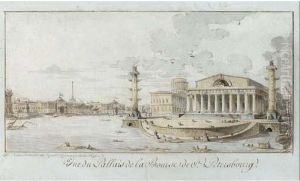Nikita Ivanovich Martos Paintings
Nikita Ivanovich Martos was a prominent Russian sculptor and art teacher born on April 10, 1754, in Ichnya, then part of the Russian Empire and present-day Ukraine. He is considered one of the founders of the Russian school of sculpture and was instrumental in transitioning Russian sculpture from the Baroque and Rococo styles that were prevalent during his early life to the Neoclassical style that characterized his mature work.
Martos studied at the Imperial Academy of Arts in St. Petersburg, where he was a pupil of the sculptor Nicolas-François Gillet. After completing his studies, he was awarded a scholarship to travel abroad, which was a common practice for talented artists of his time. He spent some time in Rome, which was the center of Neoclassical art and aesthetics. The influence of ancient Roman art and the works of contemporary Neoclassical artists, such as the famed Italian sculptor Antonio Canova, had a lasting impact on Martos's artistic style.
Upon returning to Russia, Martos became a professor at the Imperial Academy of Arts and contributed significantly to the development of Russian sculpture. He was known for his monumental works, including statues and busts of famous Russian figures such as Catherine the Great, and for his funerary monuments, the most famous of which is perhaps the tomb of Alexander Lanskoy, the lover of Catherine the Great, in the Alexander Nevsky Monastery.
Martos's work was characterized by a sense of elegance, simplicity, and harmony. He was skilled at portraying his subjects with both idealism and realism, a hallmark of Neoclassical art. His ability to capture the inner character and dignity of his subjects was highly appreciated during his time.
Nikita Ivanovich Martos served as the rector of the Imperial Academy of Arts from 1802 to 1807, influencing a generation of young artists. He received numerous honors for his contributions to Russian art, including the Order of St. Vladimir and the title of 'Academician.' He continued to work and teach until his death on August 19, 1835, leaving behind a legacy that had a profound effect on Russian sculpture and helped lay the foundations for future generations of Russian artists.
